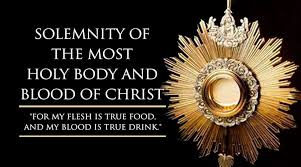Come, Let Us Adore Him
I have a deep love for Eucharistic hymns because they aid my solemn worship of the Lord Jesus Christ in the sacrament of his body and blood. Adoro Devote Te and Pange Lingua, composed by St. Thomas Aquinas in the 13th century, are my favorites of as many as five Eucharistic hymns he wrote for the celebration of Corpus Christi. These Latin hymns convey the theology of the Real Presence in a poetic and passionate tone; they simplify the essence of the mystery without a pretense of evaporating its complexity. Listening to the Latin text of the hymns set in Gregorian chant does something to my soul. I don't need to understand every word of it; I just allow the beauty and elegance of the language and music to envelop and uplift my soul, like a man in Christ caught up to the third heaven ( 1 Cor. 12:2). Singing the English translation of the hymns, I must admit, does make the experience of worship more cognitive and impactful. Understanding or lack of it thereof, these hymns aid my worship of the Eucharistic Lord truly present to eyes of faith and adored by a heart made of love.
Let's consider the first verse of Adoro te Devote briefly to illustrate my point. A typical and traditional translation of the Latin text takes this form:
"O Godhead hid, devoutly I adore Thee,
Who truly art within the forms before me;
To Thee my heart I bow with bended knee,
As failing quite in contemplating Thee.
The hymn addresses the Eucharist, whether hidden in the tabernacle or exposed in the monstrance for adoration during Corpus Christi procession, as a concealed God worthy of worship and contemplation on bended knee. Capuchin Fr. Raniero Cantalamessa, the preacher to the Papal household, captures the theology of Real Presence and call to worship contained in the hymn in the following words:
"In every stanza of the Adoro Te Devote there is a theological affirmation and an invocation which is the prayerful response of the soul to the mystery. The theological truth recalled in the first stanza refers to the manner of the presence of Christ in the Eucharistic species. The Latin expression 'vere latitas' is charged with meaning, it means: he is hidden, but he really is (where the accent is on 'vere,' only the reality of the presence) and it also means: he truly is, but hidden (where the accent is on 'latitas,' on the sacramental character of this presence)."
For the last three months, most Catholics have been without direct access to his Real Presence, to Jesus hidden in the Eucharistic species. He was hidden (using the word in a different sense here) from us because we shut the doors to the church, but he was nevertheless always present in the church. Did we for once stop by the church entrance when we drove by to genuflect or reverence Eucharistic Lord hidden in the tabernacles of our church? Were our faith fledging and our heart pulse low in love for Jesus in the Eucharist just because the closed-door hid him from our sights? I invite you on this solemnity of Corpus Christi to renew your faith and ignite in your heart the fire of love for Eucharistic Jesus by worshiping him, the hidden Godhead.
I would like to invite you to spend an hour of public worship of Jesus exposed in the monstrance this Sunday evening from 6:30 -7:30 PM. Come in your cars, bring your chairs along and come, let us adore him devoutly, the second person of the Holy Trinity.
In His Real Presence,
Fr. Bernard Oniwe, OP

 RSS Feed
RSS Feed